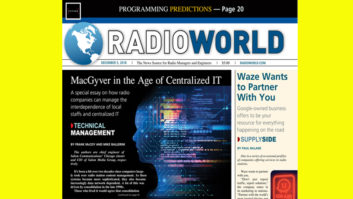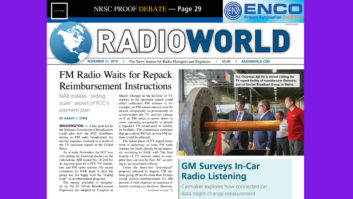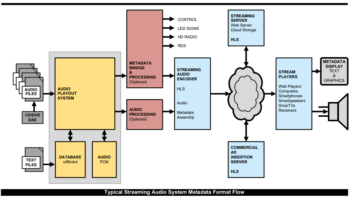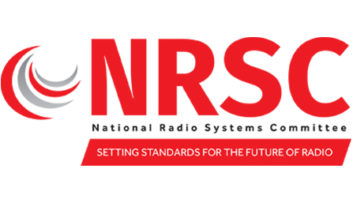Radio World has had quite a strong response from readers with perspectives about Larry Langford’s comments about removing AM proof requirements.

THIS CONVERSATION ISN’T NEW
Consulting engineer Jeremy Ruck is a longtime Radio magazine and Radio World contributor. In 2014, he wrote an article about AM NRSC measurements as part of his “RF Engineering” column.
If you read the article, you’ll note that the NRSC ambivalence is not new. Ruck writes:
A colleague and friend of mine has quipped that NRSC measurements are the “annual albatross” due to the resources spent on their acquisition. Too often, the holders of the purse strings also view the measurements as a fatuous exercise. Like any coin, there are always two sides, and the NRSC measurements are in reality another beneficial tool in the box.
Regardless of your view of them, they must be performed no less frequently than once every 14 months, and are one of the things the commission looks for when paying a visit. Since the requirements have been around for two decades, it is a challenge to have to explain to the inspector why they are absent from your files.
Don’t be that guy.
Read the full article at https://www.radioworld.com/industry/am-nrsc-measurements.
WHY HOLD ONTO THE PAST?
I appreciate the comments from other engineers talking about why it is important, however the missing point seems to be that the FCC does not require these measurements for FM or TV transmitters. All contemporary AM, FM and TV transmitters are equally reliable, and the likelihood of out-of-band emissions is very low.
Why do these engineers imagine AM is so unstable to require yearly check? Factually, out-of-band emissions from FM transmitters or digital TV transmitters, while still remote, have a much higher probability of impacting some operations that people care about: mobile phone systems.
Even in cases where mobile carriers complain about out-of-band emissions, typically the FM or TV station is well within their specification requirements; mobile operators have such sensitive receivers that they are trying to operate much beyond the norms of broadcasting.
In any event, it seems like holding onto the past for no good reason.
Unnamed prominent radio equipment manufacturer
WE DON’T KNOW WHAT WE DON’T KNOW
So, a “prominent” technology supplier says, “Why do these engineers imagine AM is so unstable to require yearly check?” This unnamed supplier goes on to say, “All contemporary AM, FM and TV transmitters are equally reliable, and the likelihood of out-of-band emissions is very low.”
I can personally attest to two AM transmitters whose elderly filter caps were the cause of spurs that exceeded FCC limits. I can also attest to measurements that eventually pointed to mixes that, while not caused by the transmitter under test, but in a mathematically and proximity related transmitter at another location.
One other thing to remember: AM transmitters can and do produce splatter if negative peaks exceed 100 percent, the definition of carrier shutoff. How many stations still operate either without accurate modulation monitors or, accidentally or on purpose crank up their modulation to the breaking point in the loudness wars that are still fought in many markets?
As a broadcast engineer with CPBE after my name, I operate under the assumption that what I don’t know can hurt my clients. I stand by the case made by me and others to keep this existing AM FCC rule and expand it to cover FM. The cost of such measurements is a small premium on a prudent insurance policy that can help assure licensees their signals are still as clean as the day they uncrated their transmitters.
We’ve all heard the line that is so well known we don’t even know who said it first: “You don’t know what you don’t know.” This excuse is in the class with “the dog ate my homework” as far as I am concerned. Periodically proofing your equipment is not just a matter of trying to avoid getting a citation. It’s really a matter of good engineering practice.
Richard A. Rudman
Owner, Remote Possibilities
COMMON FAILURES
Responding to the commentary by Larry Langford in the Nov. 7 issue in which he proposes elimination of NRSC mask measurements for AMs:
The writer might be surprised to learn how many “modern” equipment chains annually fail the equipment performance measurements under FCC 73.44, which requires not only proof of compliance with the NRSC mask but more importantly the harmonic suppression requirements, which can result in interference outside of the NRSC mask.
He might even be as shocked as broadcast engineering consultants, with regard to how many also routinely fail the annual AM EPM requirements, regardless of how current the equipment, and irrespective of NRSC compliance. In fact, what he calls “museum-like” equipment often performs better in that regard, due to its inability to reproduce the kind of interfering signals that the latest-and-greatest, “weaponized” modern equipment can transmit with ease.
FCC 73.44 actually governs much more than NRSC, and as such protects even the writer from either actual interference, or interference complaints, and/or FCC fines. Eliminating the NRSC mask in itself will do little to reduce the cost of an annual EPM for 73.44 compliance, because the NRSC measurements part can now be largely an automated process, but the certifying engineer has approximately the same costs in terms time and travel, labor and amortization of equipment, in making the also-required, out-of-band (including harmonics) measurements.
Richard Hyatt
President
Maine Engineering Associates Inc.
Portland, Maine
WHERE’S THE VALUE?
I have read with great interest the opinions of some of my colleagues regarding the usefulness of annual occupied bandwidth measurements for AM stations. Certainly some engineers earn a significant portion of their income from making such measurements, so I understand that a little bias in the direction of keeping such measurements might exist on the part of some with that underlying motivation.
From a licensee’s perspective, however, I see very little value in making annual occupied bandwidth measurements. These measurements are a burden to licensees, and in my experience, they seldom reveal any issues. Indeed, the noise floor is so high in many areas that in some cases it is impossible to resolve emissions beyond 75 kHz removed from carrier that might otherwise be above the 80 dB or 43+10log(P) limit.
There are many transmission parameter limits imposed on broadcast stations, both AM and FM, for which there are no statutory measurement intervals. What comes immediately to mind is monitoring points for conventionally-proofed AM directional stations. Field intensity limits are set for monitoring points, and licensees are required to maintain fields below those limits, but other than “as often as necessary to ensure …” stations with approved sampling systems have no requirement to measure monitoring points at any particular interval. Arguably, there is a much greater likelihood of interference to a neighbor resulting from a misadjusted or malfunctioning directional antenna than a transmitter producing out-of-band emissions. As such, wouldn’t we be well served by taking a similar approach to AM occupied bandwidth measurements?
It would seem to me that we would all be better served if the rules were consistent and the AM emission requirements in §73.44 mirrored the requirements for FM stations in §73.317. If a problem exists and a spectrum neighbor complains, measurements would then be made to determine whether the AM station is indeed the source of the problem, and then the underlying emission limitations of §73.44 would compel the AM licensee to bring his emissions into compliance. I believe such an arrangement would work very well, and it would save broadcast licensees the often substantial costs, time and trouble associated with compulsory annual measurements.
Cris Alexander
Director of Engineering Crawford Broadcasting
Aurora, Colo.
KEEP THE RULES IN PLACE
Larry omits a few of the factors involved in a proper NRSC study. The proper NRSC study includes transmitted products that can be far removed from the NRSC audio limits such as mixing products created by a nearby transmitter site, harmonics and various spurious products created inside the subject transmitter caused by aging components.
Any qualified person conducting a NRSC study should go to the transmitter and observe all working parameters of the transmitter and the modulation on a properly working modulation monitor or with a scope. Then the examined spectrum should be studied at a nearby location for harmonics, spurs (noise) and suspected mixing products predicted by a few + and – calculations using the basic and harmonic frequencies with any nearby AM transmitters in the area, and a listening scan.
Don’t hire a NRSC service that drives through town and sends you a report that you didn’t know was completed that day. They don’t even know if you are operating in the proper and normal mode.
Hear are a few findings from my history of studying these situations:
- Before any spectrum measuring, I found an AM with the asymmetrical modulation upside down, causing some carrier blanking with minor shotgun noise outside the envelope. The station also did not achieve the signal loudness as compared to other competitors as noted on the way to the transmitter. That alone was worth the cost of the study to the station, as one employee added that he always thought they did not have the presence they should on the dial. Or I will add, why sound like a 1 kW transmitter when you are a 5 kW station.
- Old electrolytic capacitors — How many of us have lived through this era of capacitors drying out and letting PDM products find a home outside the NRSC envelope? I know of one large company that had a 50 kW state-of-the-art transmitter in storage for about one and a half years before installation, and when installed about half of those large blue caps had to be replaced before the transmitter calmed down and became a good neighbor to other stations on the AM band. That same broadcasting company found that caps were the largest problem in all their newer transmitters and the caps are not cheap, almost as if we were trading the cost of tubes for the cost of regular cap replacements.
- Factory problems — I found a relatively new transmitter with real nice and strong harmonics … the problem being a missing bolt, probably shaken out during shipping. Restoring the output tuning hardware cured the problem and a group of local hams were happy on 80 meters again.
- Another modulation problem was corrected when I was listening to a small AM station on the way to the site. I listened carefully and said to myself, “What in the world is wrong with this sound?” I could not put my finger on it and thought it was the oddest sound I had ever heard on music. After meeting with the station’s “all around guy” and following what his audio line had in it, I found that when they added a streaming feed, he merely lifted the stereo output from the board and fed one line to the streaming and left the other line going to the AM audio processing path. “Why not? There are two coming off the board.”
I have many other stories, but I hope the thought about NRSC is more than just the immediate modulation mask.
I also believe that FM stations should have regular spectrum studies conducted as stations seem to move their locations without regard to other nearby assignments. Also, there seems to be a trend to have a “heavy foot” on the deviation throttle by many broadcasters. It seems that little is being done by the commission on this issue, but if we all obeyed the rules, we would be better off. Remember, the aircraft band is right next door to the FM band and many interference issues to aviation come up due to spurs and other issues from our FM band.
Today, stations are on tight budgets and have decided that as long as the needle is still bouncing, they do not need any extra engineering oversight.
I find this to be totally wrong, and many cures and prevention can happen with a qualified extra set of eyes overseeing the facility annually. Just be there with the NRSC person and have them give the station a good listening and check up before even starting the NRSC measurements.
Let’s keep the NRSC rules in place.
Hal Williams, N6TZ
Camarillo, Calif.
DITCH THE REQUIREMENT
A few engineers whom I highly respect have weighed in on this subject both for and against the annual occupied bandwidth measurement.
Richard Rudman is correct that old capacitors in some AM transmitters can cause issues; I recently repaired a Gates one that had bad caps in it. And other issues can cause distortion or noise outside the FCC limits, yet we don’t have annual audio proof requirements.
Transmitters can drift out of frequency tolerance, but we don’t require frequency monitors any longer or mandate frequency measurements at all. Many things used to be required to be checked daily, weekly, monthly or yearly and are now at the discretion of the licensee (including monitor point readings or in some cases no requirement to read AM antenna base currents).
I remember reading base currents for both day and night patterns once a day in my early years of working as an engineer, and driving around weekly to the monitor points, both with day and night patterns. We don’t do this any longer. We don’t do monthly frequency checks or annual audio proofs of performance. Heck, we don’t even have to check tower lights daily, if we have the right type of monitor/alarm equipment!
All those other things have been relegated to an as-needed basis, the commission putting the burden of compliance on the licensees. Why is one issue more important than another? Interference you say? Overmodulation causes splatter and interference. But we don’t require a station to have a modulation monitor, yet the licensee is expected to be in compliance. An AM station with its directional antenna out of tolerance can cause interference. Again, it is up to the licensee to determine compliance.
I say ditch the requirement and put it in the same category as all the other things that we used to do on a required basis but now only as the licensee deems necessary.
Hal Kneller
Engineering Consultant
OPERATING IN TECHNICAL LIMBO
Larry: It is with some hesitation that I question your so-called “useless rule” regarding the FCC’s mandated, yearly NRSC Occupied Bandwidth and Harmonic Testing.
Without a doubt, every one of us has our own perspective on just about everything.
More now than ever before, many a broadcaster’s perspective is motivated by cost. This is completely understandable, but sometimes it is motivated by bad experiences, or whatever our mindset might be.
When cost becomes our motivation, often coupled with a partial or incomplete understanding, as to “why” the FCC has mandated a particular regulation, or when we find it personally difficult to eek out their guidelines and technical reasoning, as to why certain things that “broadcasters and their engineers” are required to do, by the FCC, in order to satisfy “consistent standards of operation,” then our “perspective” can sometimes become erroneous. I am no exception!
Regarding “perspective:” I will admit to being an engineering service. I will admit to NRSC measurements being one of the sources of our income. I will admit that approximately 65 to 70 percent of the stations that we measure are fairly consistent in passing the “NRSC Occupied Bandwidth and Harmonic Proof.” However, it isn’t always the same stations that “fail or pass” the yearly NRSC and harmonic proof standards.
Thus, I would ask: Is a 65 to 70 percent passing grade a “good enough” goal for anyone, or anything? I would never get on a plane that has a 70 percent rating. I would not buy a car that has a 70 percent rating. (“And so it goes,” as Linda Ellerbee says.)
Sorry Larry, but from my perspective, I don’t feel that very many of the stations that I measure are ready to go without a (basic) FCC yearly checkup. Many stations do not have a routine engineer, or the necessary equipment to assure that their station is meeting “FCC standards,” and thus those stations are often operating in technical limbo. Admittedly, they make an honest, daily, effort to stay on the air as best as they can.
Just like you, I, too, have owned and operated a station and know the “nickel and dime” costs that eat at the heels of broadcasters. All too often it seems that our regulators (local, state, federal) don’t realize that, especially the small-market broadcasters (let us include all broadcasters) are in a delicate and competitive situation. However, this also affects all businesses, not just “broadcasters,” and it isn’t going away.
Larry, I do understand your frustration. I wish I had a good answer, to put you at ease with the mandate.
Keep in mind that, at present, the FCC’s yearly mandated NRSC and harmonic proof is the only documented “proof of performance” requirement that stations have. It lets the stations know what may need fixing, in order to make their broadcast system compatible with their listener’s receivers, and at the same time not interfere with other stations.
All things will eventually change — some for better — some for the worse.
Frank Hertel
Newman-Kees Hertel RF Measurements & Engineering
Evansville, Ind.












